Below are some of the typical weeds found in our area. Call us today to identify the weeds in your yard and to discuss the best options to get rid of them permanently.
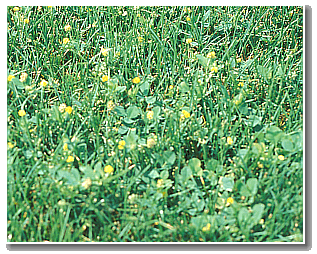
Broadleaf Lawn Weeds
Black Medic (Medicago lupulina)
Annual, broadleaf (sometimes survives as a short-lived perennial)
Range: throughout the United States
Appearance: With its three leaflet, clover-like leaves, this legume is often confused with white clover. Low growing, with trailing, slightly hairy stems, it produces clusters of small, bright yellow flowers in late spring to early summer.
Growth: Black medic is common in lawns from May through September. It is especially prevalent in dry soils where turf is spotty and in high-phosphorus soils. Though an annual, it can be as persistent as a perennial.
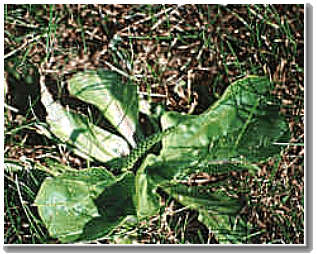
Broadleaf Plantain (Plantago majo)
Perennial, broadleaf
Range: throughout the United States and southern Canada
Appearance: Broadleaf plantain has gray-green, egg-shaped, wavy-edged leaves growing in ground-hugging rosettes. Narrow seed heads appear in a long cluster on a central, upright stem.
Growth: Rosettes appear in midspring in thin and weakened turf. Seed stalks rise from early summer through September. The rosette has a tendency to suffocate desirable lawn grasses. Plantain grows from seed and resprouting roots. Seed germinates best in rich, moist, compacted soil.
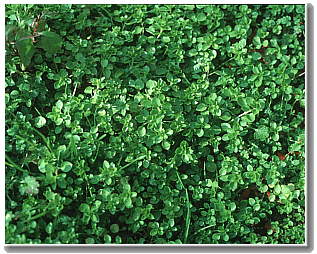
Common Chickweed (Stellaria Media)
Range: throughout the United States except in the Rocky Mountains
Appearance: Common chickweed is a shallow fibrous rooted winter annual which grows in moist shaded areas. The leaves are small, smooth, pointed at the tip and elliptic in shape. They are opposite on branching creeping stems, which root at the nodes. Chickweed adapts well to different mowing heights. The flowers of common chickweed are white small star like with 5 notched petals. Common chickweed spreads by seed.
Growth: Common Chickweed thrives in cool, moist areas. Growing conditions can be made less favorable by lightening the soil or otherwise improving drainage, especially in shady areas. Heavy, constant shade should be lightened as well where possible. Shady areas should be planted with turfgrass species which do well in the shade and which will provide maximum competition to weed species which invade shady areas.
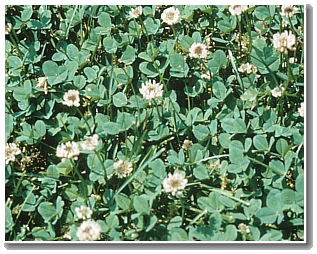
Clover (Trifolium repens)
Perennial
Range: throughout the United States
Appearance: The leaves are compound, with 3 broad leaflets (sometimes 4, if you’re lucky!) 1.3 – 2.5 cm long, with tiny teeth on the edges, a pale triangular mark appears on each leaflet.
Growth: Appear from May to September
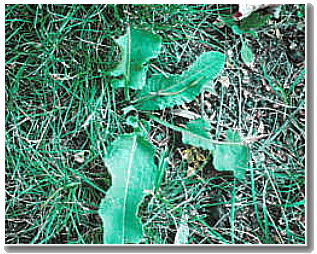
Curly Dock (Rumex crispus)
Perennial, broadleaf
Range: throughout the United States
Appearance: Bright, shiny green, lance-shaped leaves appear in spring. In summer and fall, the puckered wavy edges of the leaves are tinted reddish purple. Flowers appear on a tall, narrow spike coming from the center of the plant.
Growth: Growing from a large, brownish taproot, curly dock is a perennial weed that grows most actively when grass is suffering from the stress of hot, dry weather.
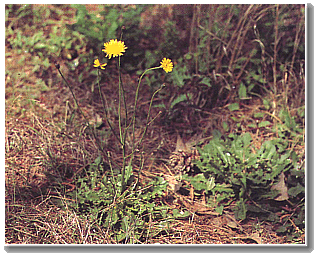
Dandelion (Taraxacum officinale)
Perennial, broadleaf
Range: throughout the United States
Appearance: Everyone recognizes the bright yellow flowers of dandelions; they appear in early spring and are followed by puffy seed heads. They arise from rosettes of lance-shaped leaves.
Growth: Dandelions emerge in early spring, with flowering commencing as early as April and continuing through summer and fall. The plants reproduce from a long taproot, and from seeds. Seedlings can germinate at any time throughout the growing season.
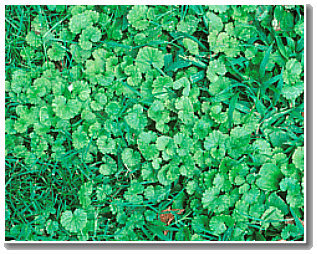
Ground Ivy (Glechoma hederaceae)
Broadleaf
Range: throughout the United States
Appearance: Also called creeping Charlie, is a common lawn weed problem. Lawns in shaded areas and often with poorly drained fertile soil are typical sites for ground ivy to develop into a major problem. This plant may form extensive patches as it creeps along the soil and can move into sun areas. Stems are square. Leaves are arranged opposite of each other along stems, and are round to somewhat kidney shaped with rounded, toothed margins. Crushed leaves have a minty odor. Ground ivy has small funnel-shaped purplish-blue flowers.
Growth: April To June
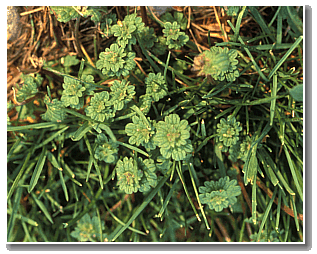
Henbit (Lamium Amplexicaule)
Range: throughout the United States
Appearance: Henbit, a member of the mint family, is an upright winter annual that blooms in the spring. The leaves are rounded on the end with rounded toothed edges that grow opposite one another on square stems Upper leaves lack petioles. Henbit can grow from 4 to 12 inches tall on weak stems.
Growth: Although an upright plant, weak stems sprouting from the bottom may lay almost horizontal. Henbit spreads only by seed and is generally not a problem in dense, vigorous turfgrass sites.
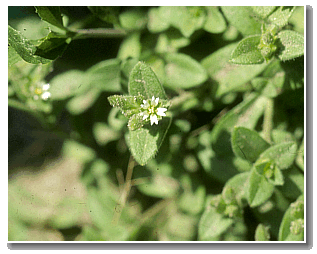
Mouse-Ear Chickweed (Cerastium fontanum vulgare)
Annual or perennial, broadleaf
Range: throughout the United States
Appearance: The name of this weed offers a clue to its appearance. It has long, narrow, fleshy leaves that look fuzzy. Small, white flowers appear in late spring and early summer, followed by seed heads in mid summer.
Growth: This weed grows most actively during spring and early summer when it spreads by means of creeping stems that root at the nodes. It grows close to the ground and can withstand low mowing. It grows vigorously in moist, poorly drained, and shaded areas.
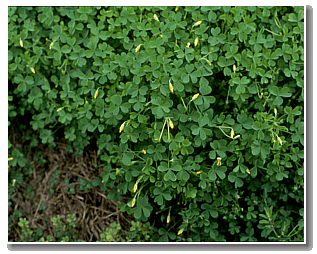
Oxalis (Oxalidaceae)
Perennial
Range: throughout the United States
Appearance: Has bright yellow flowers and green leaves. It grows upright. O. europaea (also called O. Oxalidaceae) is a perennial with seeds and rootstocks so that it sometimes appears to be a creeping vine. The leaves and stems are often purple or reddish.
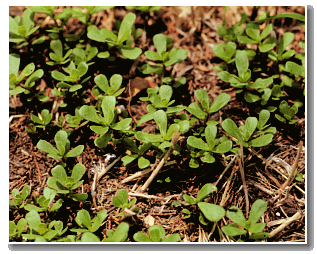
Purslane (Portulaca oleracea)
Annual, broadleaf
Range: throughout the United States, especially troublesome east of the Mississippi River
Appearance: Sprawling, thick, fleshy stems with rubbery leaves. Tiny, yellow, five-petaled flowers open when the sun is shining brightly. Cup-shaped seedpods produce many small, black seeds that may lie dormant in the soil for years. Seldom found in the spring when the lawn is treated for other weeds.
Growth: Thrives in hot, dry weather, spreading by sprawling stems. It’s extremely troublesome in thin areas of the lawn or in new lawns seeded in summer.
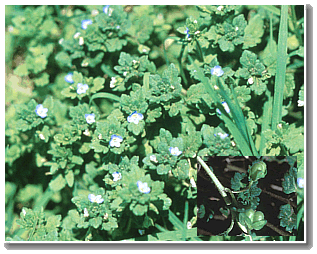
Speedwell (Veronica officinalis)
Perennial or annual, broadleaf
Range: Eastern half of the northeastern United States, except in the extreme South
Appearance: There are several types of speedwell, all characterized by small, lobed, and numerous leaves, and by tiny white or purple flowers. The scallop-edged leaves are paired, growing opposite each other. Heart-shaped seed pods grow on the stems below the flowers.
Growth: Speedwells are among the earliest of lawn weeds to appear, greening up as early as late winter. Most are characterized by creeping stems that root at the nodes. Some show an erect growth habit as they mature. They all thrive in cool, moist soils where turf has thinned.
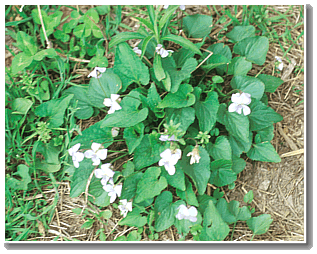
Wild Violet (Viola Pratincola)
Winter Perennial
Range: throughout the United States
Appearance: Wild violet is a winter perennial, growing 2 – 5 inches tall. It can have a tap root or a fibrous root system, and also can produce rooting stolons and rhizomes. The leaves can vary but usually are heart shaped, on long petioles with scalloped to shallow rounded margins. The flowers of wild violet range from white to blue to purple. Wild violet flowers are pansy-like with three lower petals and two lateral petals on long single flower stalks.
Growth: Appear from March to June
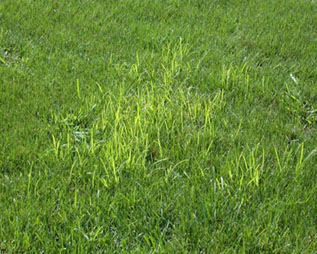
Sedge Lawn Weeds
Yellow Nutsedge (Cyperus esculentus)
Perennial, grassy
Range: throughout the United States
A related species, purple nutsedge, is especially prevalent in the Southeast
Appearance: Though it resembles a grass, yellow nutsedge is actually a sedge. Its coarse, light green leaves grow upright from triangular stems. Seed heads appear from July to October.
Growth: Reproduces mainly from underground tubers; however, they can reproduce by seeds and underground stems. Tubers store food and are drought tolerant. Yellow nutsedge grows vigorously in summer, especially under moist conditions; primarily troublesome in closely mowed lawns.
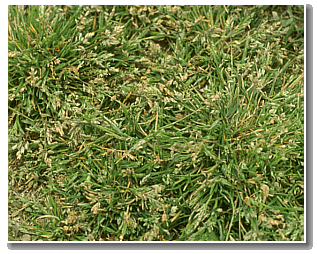
Grassy Lawn Weeds
Annual Bluegrass (Poa Annua)
Range: throughout the United States
Appearance: Annual bluegrass has a boat-shaped tip, folded in the bud. The ligule is membranous and auricles are absent. Annual bluegrass has a small panicle seedhead.
Growth: Annual bluegrass contains both annual and perennial species. Annual bluegrass forms dense patches that can withstand low mowing heights. Germination occurs in late summer and early spring.
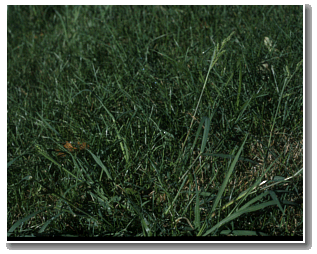
Barnyard Grass (Echinochloa Crusgalli)
Range: throughout the United States and Mexico
Appearance: The leaves of barnyardgrass are rolled in the bud and contain neither a ligule nor auricles; the sheath is open but compressed. The mid-vein is thick and keeled; roots are fibrous.
Growth: Barnyardgrass is a summer annual which has tillers which lie flat and form secondary roots resulting in a mat formation. Barnyardgrass spreads by seed which germinate in late spring and early summer. The seedhead is a coarsely branched green to purplish panicle with spiked awns.
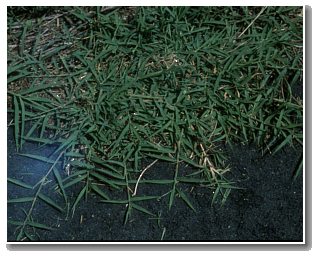
Bermuda Grass (Cynoden Dactylon)
Range: Southern areas of the United States
Appearance: The leaves of bermudagrass are folded in the bud, and the sheath is strongly compressed. The leaf is short, approximately 1/8 inch wide with rough edges. The seedhead of Bermudagrass consists of 3 – 7 finger-like spikes.
Growth: Bermudagrass is found in open sunny areas. Bermudagrass does not grow in the shade. It can be found in turf, landscapes and in most cultural crops. Bermudagrass is very tolerant of low mowing, and can be found on both dry and wet soils.
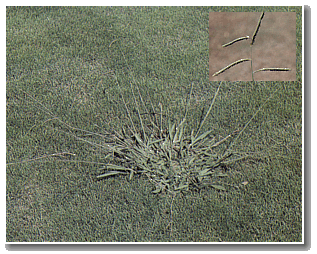
Dallis Grass (Paspalum dilatatum)
Perennial, grassy
Range: Coastal states from New Jersey to California, and as far north as Missouri
Appearance: Coarse blades, somewhat upright in a bunch-type growth. Rhizomes are so closely jointed that they appear almost scaly. Stems 2 to 6 inches long emerge from the plant center in a starlike pattern. Seed heads are sparsely branched on long stems. Seeds lie dormant over the winter and sprout very early in spring.
Growth: This is a summer weed in many areas of the country, but it grows throughout the year in mild climates, and thrives in those areas that are low and wet.
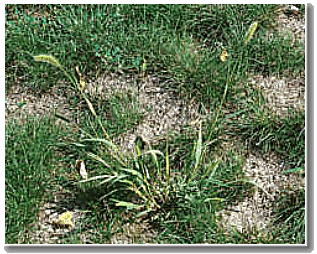
Foxtail (Setaria Glauca)
Range: throughout the United States
Appearance: he leaves are rolled in the bud. The collar is narrow and continuous. The seedhead is a bushy, erect spike which resembles the tail of a fox. GROWTH: Yellow foxtail is a summer annual which germinates when soil temperatures reach 65 degrees F.
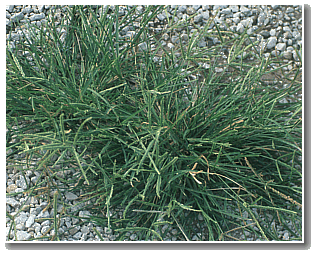
Goose Grass
Range: Goosegrass is found in the United States from the transition zone south
Appearance: Goosegrass is a prostrate-growing summer annual. The leaves are folded in the bud. Goosegrass grows in a clump with the base of the leaves being distinctively white to silver in color. The ligule is toothed, membranous, and divided at the center. Goosegrass contains hairs only at the base of the leaf.
Growth: Goosegrass is highly competitive during hot summers, and can outcompete desirable grasses where soil is compacted. Core aeration should be provided to improve soil conditions for desirable grasses. Single plants can be physically removed with a knife. Do not seed when soil and weather conditions are appropriate for the germination of goosegrass (60 to 65 degrees F). A slightly raised mowing height may help prevent the establishment of crabgrass by providing shade from sunlight.
Smooth Crabgrass and Hairy Crabgrass (Digitaria Ischaemum and D. Sanguinalis)
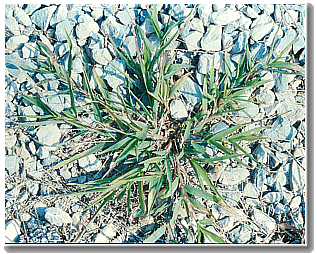
Annual, grassy
Range: throughout the United States
Appearance: Smooth and hairy crabgrass have a prostrate growth habit with coarse, light green blades. The blades are short, pointed, and hairy.
Growth: This vigorous, warm-season annual grass grows rapidly from early spring until seed heads form in late summer to early fall. It grows especially well in lawns that are watered lightly, underfertilized, poorly drained, and growing thinly. The plant spreads by seed, and to a lesser extent, by rooting from the lower swollen nodes of stems.

